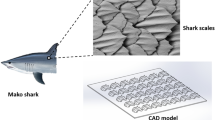Abstract
It is well known that shark skin surface can effectively inhabit the occurrence of turbulence and reduce the wall friction, but in order to understand the mechanism of drag reduction, one has to solve the problem of the turbulent flow on grooved-scale surface, and in that respect, the direct numerical simulation is an important tool. In this article, based on the real biological shark skin, the model of real shark skin is built through high-accurate scanning and data processing. The turbulent flow on a real shark skin is comprehensively simulated, and based on the simulation, the drag reduction mechanism is discussed. In addition, in order to validate the drag-reducing effect of shark skin surface, actual experiments were carried out in water tunnel, and the experimental results are approximately consistent with the numerical simulation.
Similar content being viewed by others
References
WALSH M. J. Riblets as a viscous drag reduction technique[J]. Aiaa Journal, 1983, 21(4): 485–486.
GAO Wei, LIU Ru-xun and DUAN Ya-li. Numerical investigation on non-Newtonian flows through double constrictions by an unstructured finite volume method[J]. Journal of Hydrodynamics, 2009, 21(5): 622–632.
TIAN Li-mei, REN Lu-quan and LIU Qing-ping et al. The mechanism of drag reduction around bodies of revolution using bionic non-smooth surfaces[J]. Journal of Bionic Engineer-ing, 2007, 4(2): 109–116.
QIU Xiang, ZHANG Dao-xiang and LU Zhi-ming et al. Turbulent mixing and evolution in a stably stratified flow with a temperature step[J]. Journal of Hydrodynamics, 2009, 21(1): 84–92.
TARAFDAR S., NAG S. and DUTTA T. et al. Computer simulation of viscous fingering in a lifting Hele-Shaw cell with grooved plates[J]. Pramana-Journal of Physics, 2009, 73(4): 743–754.
ZOU Lin, LIN Yu-feng. Force reduction of flow around a sinusoidal wavy cylinder[J]. Journal of Hydrodynamics, 2009, 21(3): 308–315.
BENHAMZA M. E., BELAID F. Computation of turbulent channel flow with variable spacing riblets[J]. Mechanika, 2009, 79(5): 36–41.
HUANG Jian, MURAI Yuichi and YAMAMOTO Fujio. Quadrant analysis of bubble induced velocity fluctuations in a transitional boundary layer[J]. Journal of Hydrodynamics, 2009, 21(1): 93–99.
LIU Jian-min, LU Chuan-jing and XUE Lei-ping. Numerical investigation on the aeroelastic behavior of an airship with hull-fin configuration[J]. Journal of Hydrodynamics, 2010, 22(2): 207–213.
DONG Zhi, ZHAN Jie-min. Numercial modeling of wave evolution and runup in shallow water[J]. Journal of Hydrodynamics, 2009, 21(6): 731–738.
GONG Kai, LIU Hua and WANG Ben-long. Water entry of a wedge based on Sph model with an improved boundary treatment[J]. Journal of Hydrodynamics, 2010, 21(6): 750–757.
CHOI H., MOIN P. and KIM J. Direct numerical simulation of turbulent flow over riblets[J]. J. Fluid Mech., 1993, 255: 503–539.
CONG Qian, FENG Yun and REN Lu-quan. Affecting of riblets shape of non-smooth surface on drag reduction[J]. Journal of Hydrodynamics, Ser. A, 2006, 21(2): 232–238(in Chinese).
LIU Zhi-hua, DONG Wen-cai and XIONG Ying et al. Analysis on factors and mechanism of drag reduction by grooved surface[J]. Journal of Ship Mechanics, 2007, 11(6): 820–830.
BECHERT D. W., BARTENWERFER M. and HOPPE G. et al. Drag reduction mechanisms derived from shark skin[M]. New York: American Institute of Aeronautics and Astronautics, Inc., 1986, 2: 1044–1068.
KLUMPP S., MEINKE M. and SCHRÖDER W. Numerical simulation of riblet controlled spatial transition in a zero-pressure-gradient boundary layer[J]. Flow Turbulence Combust, 2010, 85(1): 57–71.
HAN Xin, ZHANG De-yuan. Study on the microreplication of shark skin[J]. Science in China Series E: Technological Sciences, 2008, 51(7): 890–896.
HAN Xin, ZHANG De-yuan and LI Xiang et al. Bio-replicated forming of the biomimetic drag-reducing surfaces in large area based on shark skin[J]. Chinese Science Bulletin, 2008, 53(10): 1587–1592.
DANIEL T. L. Fish mucus: In situ measurements of polymer drag reduction[J]. Biol. Bull, 1981, 160: 376–382.
Author information
Authors and Affiliations
Corresponding author
Additional information
Project supported by the National Natural Science Foundation of China (Grant No. 50775006), the National High Technology Research and Development Program of China (863 Program, Grant No. 2009AA043802).
Biography: ZHANG De-yuan (1963-), Male, Ph. D., Professor
Rights and permissions
About this article
Cite this article
Zhang, Dy., Luo, Yh., Li, X. et al. Numerical Simulation and Experimental Study of Drag-Reducing Surface of a Real Shark Skin. J Hydrodyn 23, 204–211 (2011). https://doi.org/10.1016/S1001-6058(10)60105-9
Received:
Revised:
Published:
Issue Date:
DOI: https://doi.org/10.1016/S1001-6058(10)60105-9



